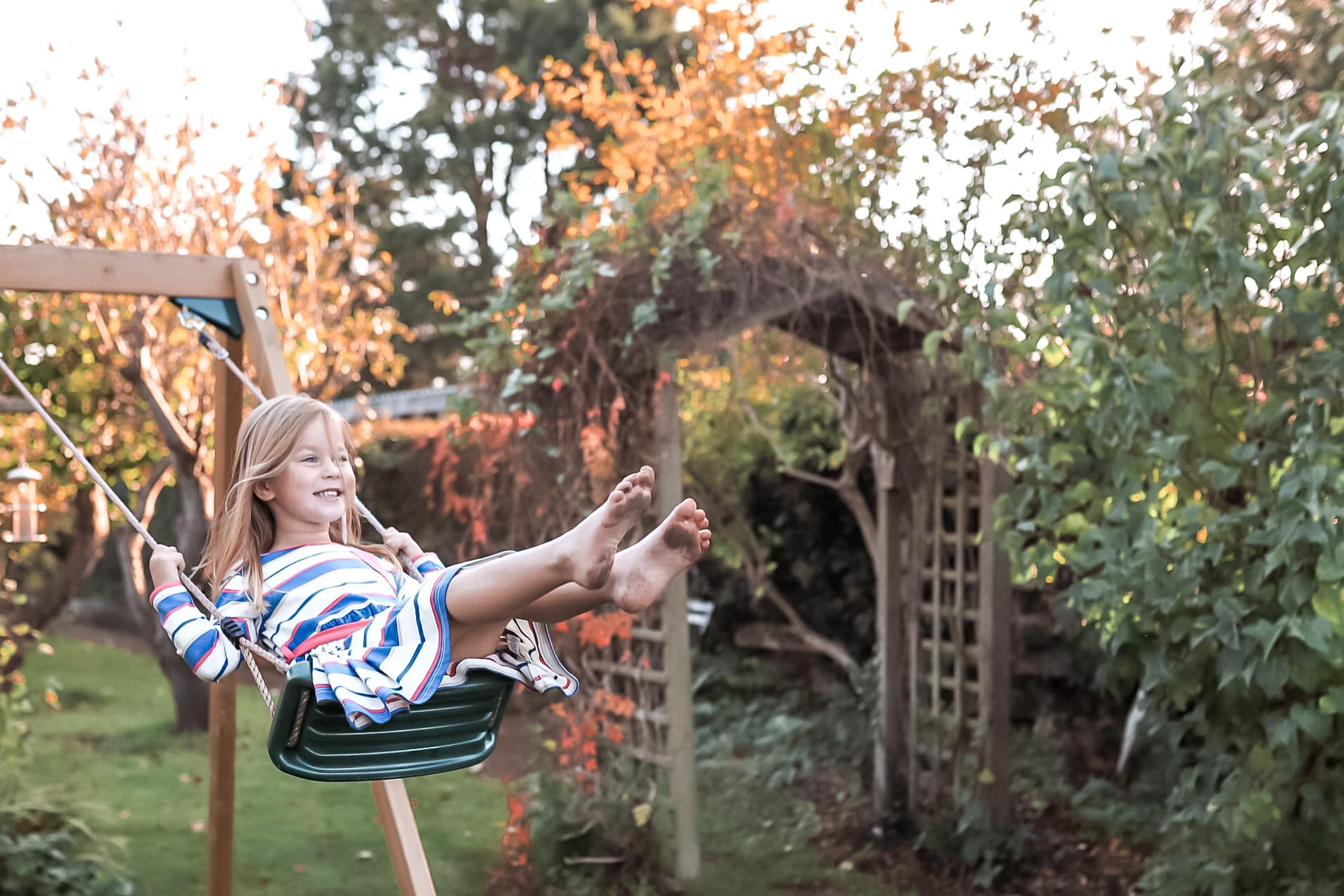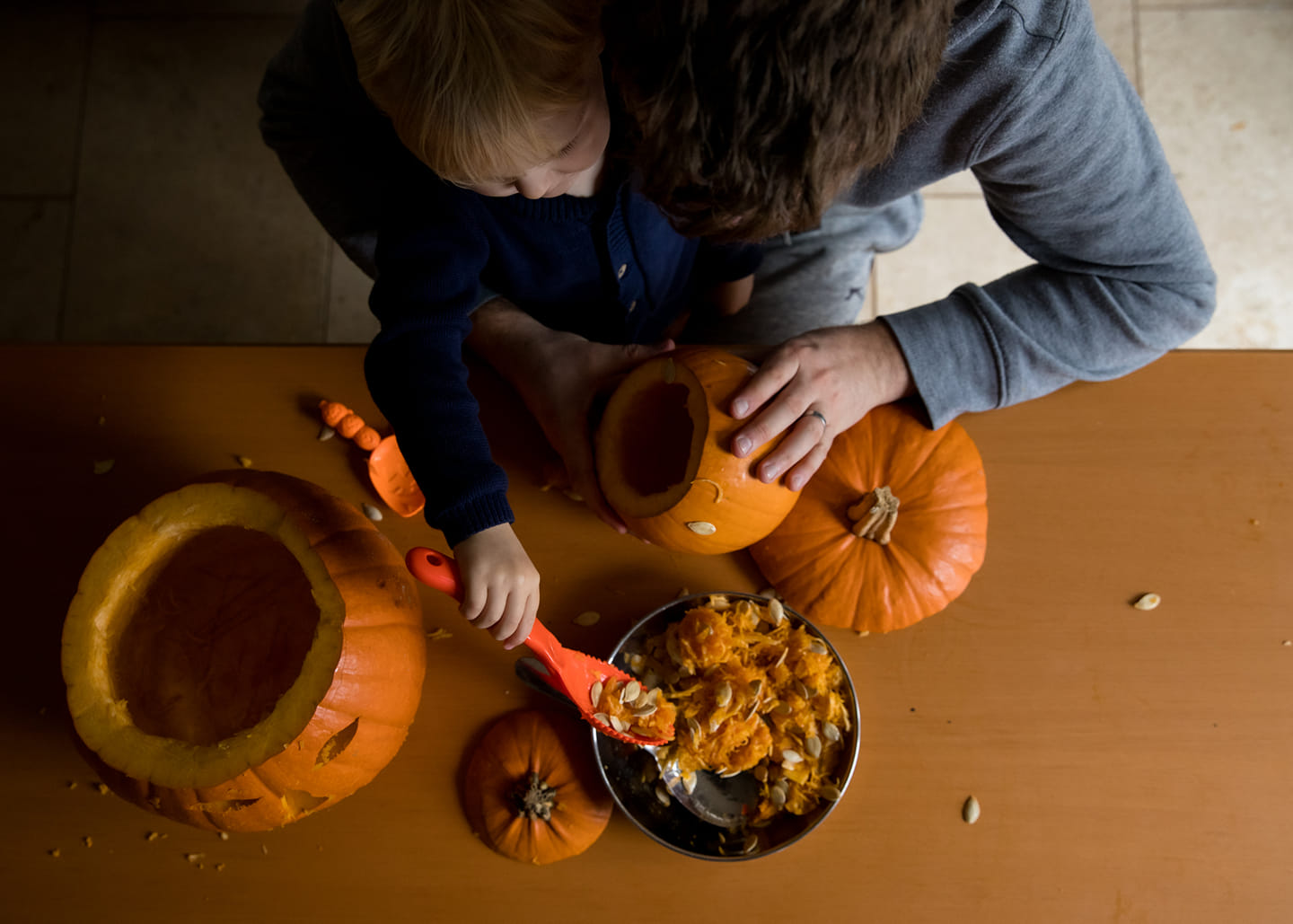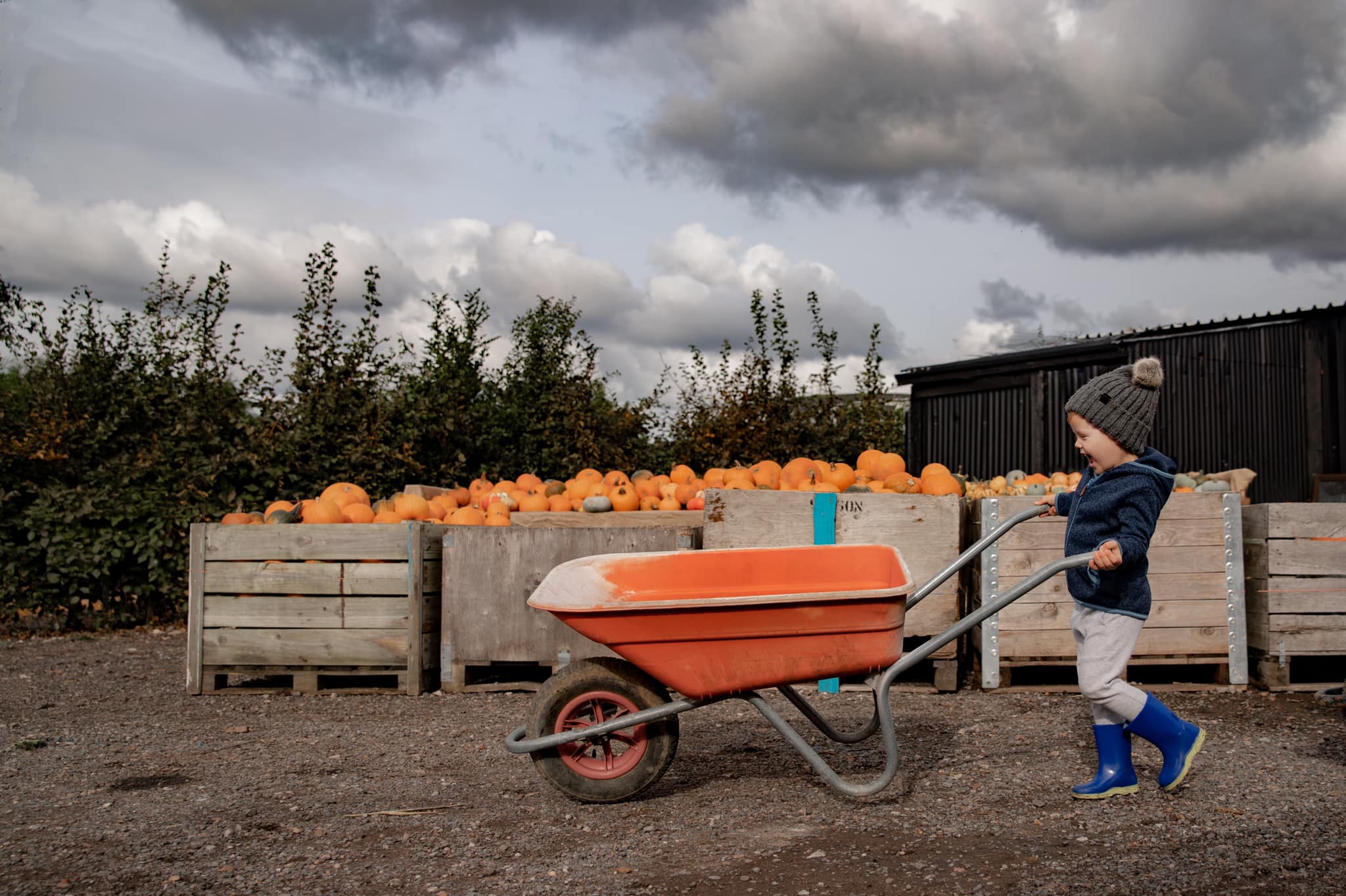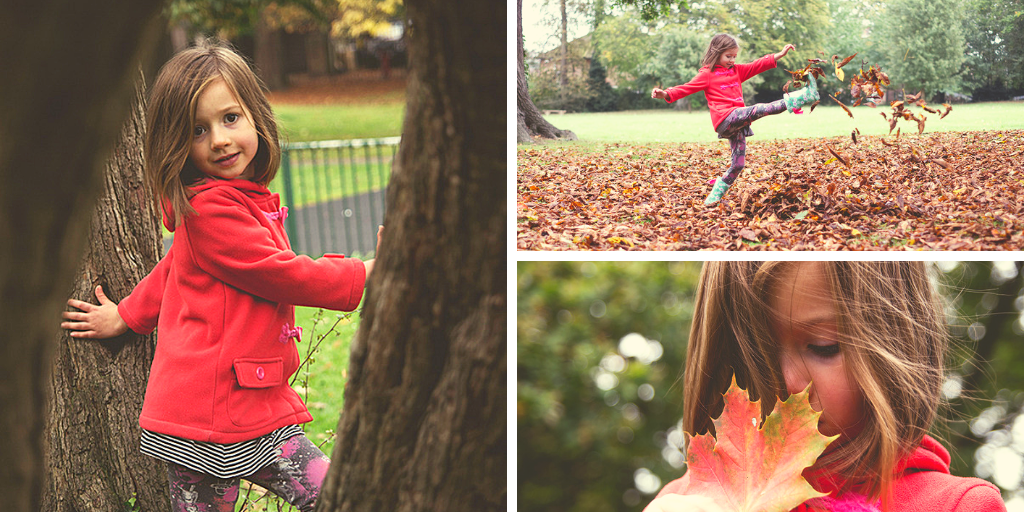Yesterday, we asked you to pay attention to colours. To really see them in your images, to notice how light affects them, to see how they complement or contrast with one another.
Today, it's a change of gear. Today, we want you to pay more attention to the STORY.
Erm, storytelling? I just want to take nice photos of my kids!
You may not be thinking about it, but with every photo that you take, you are telling a story. A small or big story, but story nonetheless. Understanding that story is is actually just answering the question - what is this photo about? Because yes, it's a photo is OF your kids. But what is it ABOUT?
And that story, that ABOUT can be complex but it can also be simple.
Let's take this photo, captured by one of our grads Claire Frisby. Yes, it's a photo of her daughter, but it's about more than that. What I'm reading from this image is that Claire watched her daughter on the swing and she loved the joyful smile when her daughter was whooshing through the air, she loved the autumnal colours of her garden, but she also loved the mucky feet and how her daughter doesn't mind being barefoot in the colder months and how it's a little detail her Mum loves about her.

Photo by Claire Frisby
Or how about his one? By another grad of ours Amanda Gratwick
Yes, Amanda saw her son and his Dad carving a pumpkin. But what she also saw was the closeness between them, the connection and the little boy learning something from his Dad. Also maybe a little about how the innards of a pumpkin are a little icky. But if the image was just about boy carving his pumpkin, she could have just zoomed in on this. If the image was just about their connection, she could have zoomed in on their faces. But because this story, this image was about more, this shooting angle which reveals their closenes, connection, action, context - was a brilliant choice.

And how about this one - this one is by Kerry Anderson
On a surface it's a photo about a boy exited to be pushing the big wheelbarrow. If the pumpkins disappeared from view, that would be exactly what this image is about. That would be the story. But making sure that we get to see more - the pumpkins piled up right behind him, the larger view - all of that gives us clues as to where and when this may be happening and also why.

Important visual clues
In the images above the photographers paid careful attention to what made it into the image and into the story. In each of those images, the photographer included important clues that helped tell a story - the first image was not just of the mucky feet - the autumnal colours in the background help us place in in a time of the year that for most people is incompatible with bare feet - that's what makes that story interesting. The wheelbarrow shot would not be telling us the same story if it hadn't been for the pumpkins etc.
Those visual clues are so important, but we often forget about paying attention and including them when we are in the moment because - well, we are in the moment. We KNOW our kids. As photographers, we ARE where the action is taking place. We understand WHO they are, WHERE they are, WHAT they are doing of feeling. And since we know it all, we're not thinking about it making it into the images. We forget that the image might be seen by someone else who did not have the benefit of being there and we deliver an incomplete story.
The Nan test
I like to pass my photos through a Nan test - it's simple - if you were to send your photo to your Nan, would she understand the story? Who and what it is about? And where and when it was taken? This week, we're preoccupied by capturing images that are all about autumn, so as you snap away, I want you to consider whether what you see through your viewfinder will have enough visual clues to tell the viewer it's autumn? Would you Nan know those images were taken in Autumn if she were to see them in 6 months time?
Getting to the story
To get to the story, I like to take cue from the writers. Writers take a character, set it in a place or circumstances and then throw in details that give us that bit of extra. And it's easy to translate that process to photography
All you need to do, is before you just snap snap snap, pause for a second and ask yourself those three questions:
WHO OR WHAT is this story about? A person or the action?
If you want a portrait, it's simple - it's just about your child - what they look like, and how they melt you inside. But often, especially for us parents-photographers, the memory keepers, it's about more than that. It might be about what they are doing, who they are with, how it is affecting them? And how it makes you feel?
The SETTING - where are we and does it matter ?
Is where you and your kids are important to the story? Would someone else understand what's going on without being told? And crucially - does it matter to point 1? In the wheelbarrow photo above, the WHERE was pretty crucial to the image but in a portrait, it might not
ANY JUICY DETAILS
A story doesn't feel real if we only talk about generics. It's the little details that make it special, engaging and unique. It may be how your child sticks out their tongue as they concentrate or that they like to run around barefoot all year long as we saw in Claire's photo above.
And I know what you're thinking. This feels like a lot to be thinking about and cram into one image while you just want a simple nice photo of your child.
But what if we broke it down into 3 parts?
We have an exercise that helps you do just that. Break it down so that you can still capture what happens, without the overwhelm. If you're familiar with our bootcamps and courses, you have probably seen this one already, but it makes such a difference, it helps so much with getting into a habit of storytelling, that I can't not include it here. And by learning to take those three steps, and to take them one at a time, you learn to think about the story.
I like to call this little exercise- 1-2-3 story.
It's really simple. What you do, is instead of capturing 1 photo, you take 3. But 3 specific ones that each add a bit to the story.
And it starts with the photo you take ALL the time. You have one, I do too.
Your GO-TO shot
You may well be the exception, but it's usually a shot that captures your child's face, maybe a bit of upper body. It's only natural - that's the shot that's all about your child : you focus, you shoot, done. And then you take it again and again and again. Yours might not be a portrait, but I guarantee that in your photo gallery, there is more of one type of photo than another.
Everybody has that go-to shot - the one that we seemingly take over and over again.
It just feels good, familiar, we like the outcome, we know the composition works.
So what's the problem?
Absolutely nothing wrong with a portrait. In fact, we'll be doing just those tomorrow. But that one type of shot will only communicate so much. The story is limited here. And for a parent photographer, that storytelling through photography is really key because when you go back and look back at it in years from now, you want to remember more than how a person looked.
So here is what you do.
1. You take your go-to shot. Who / What is this about?
You like it, you know it works, you should absolutely capture it. You’ve got it, you can relax, you know you have something there that you like. It’s usually about the person - about your child more than anything else.
But then, you will be taking 2 more photos.
2. Go wide - Where is your subject?
The second photo you take, you go wider. Imagine that you have a zoom in your head, so in this second photo you are zooming yourself out. You are now seeing your subject in a wider context of their environment. This helps you capture and communicate where they are and what’s going on. It helps you capture some of that beautiful autumnal view and just place your subject in a time and place.
3. Zoom in - the juicy details
So for now, we have got 2 sides to the story - the one about the person, and the one about the wider context. But we’re not done yet. No story - written or otherwise - could be complete without focus on detail.
In the third photo, you go to the other extreme and zoom in on a detail. It could be a detail of your child or of their environment. Make it all about that one thing, really zoom in or crop tight to get it.

Lesson 2 Challenge
I want you to capture a story in 3 parts t.
About the person - WHO? is this about?
About the person in the environment - wider view - WHERE is this? WHAT's Going on?
About the detail - SOMETHING SPECIAL? IS there a detail that's a part of that story that's worth capturing?
Don’t forget to post your photos to our Facebook group!
More examples on the next page! >>>>>>>>
Do you know about us?
When you join Photography for Parents courses, we give you all round photo skills with a focus on photographing children.
We do A LOT on camera know-how, but we also spend lots of time on the softer side of things - like composition and storytelling and learning how to capture and express emotions through your photos.
You already know that you can win a place on one of our course just for taking an active part in this summer project, but just in case Lady Luck is not on your side, I want to let you know we will have a rather wonderful offer for you at the end of this course....
Just saying...
